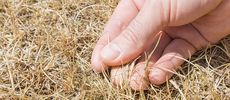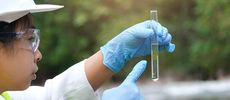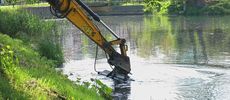Genki Balls Are Improving Water Quality in Downtown Honolulu Canal


Mud, trash, pollutants, and organic debris are the ingredients for sludge—and for years, sludge has been the defining characteristic of the Ala Wai Canal in Honolulu.
Sludge, which is rotten organic material, forms when putrefying, decaying bacteria decompose organic matter in conditions of deficient oxygen. The process produces harmful and smelly gases like methane, ammonia, and hydrogen sulfide. In the Ala Wai canal, the result of this sludge is a toxic environment—and better water quality seemed impossible given the canal's murky water and noxious smell.
To clean up the canal, the nonprofit Genki Ala Wai Project chose a method that might seem counterintuitive: throw a whole lot of mud balls in the canal. But the balls, called Genki after the Japanese word for health, contain effective microorganisms (EM) that sink to the bottom of the canal and digest sludge.
Let's take a deep dive into the Ala Wai Canal, Genki balls, their potential for clarifying polluted waters, and the water quality testing that's critical to ensure the success of any remediation project.
EMs Promote Healthy Plant Growth
Valuable discoveries are often made by accident, and that was the case with EM. Dr. Teruo Higa, professor emeritus of horticulture at Ryukyus University in Okinawa, Japan, discovered EM after an incident of pesticide poisoning.
While growing oranges, he noticed a decline in his overall health. He started to break out in rashes, and his symptoms got progressively worse the longer he worked with and near agrochemicals. That experience deeply influenced his thinking and launched 15 years of exhaustive research into safe and harmless microorganisms for crop cultivation, culminating in EM.
Dr. Higa recognized that the key is the combination of microbes. In 1980, after many experiments, he discovered an optimal mix of microbes—which he called "EM"—that promoted healthy plant growth.
EMs in Genki Balls Eat Up Sludge
EMs are a mixture of aerobic and anaerobic cultures found in the natural environment. They are primarily lactic acid bacteria mixed with yeast and phototrophic bacteria, whose energy comes from light and various carbon sources. Food production uses lactic acid bacteria and yeast, and the U.S. Food and Drug Administration recognizes both as generally safe for humans.
To create these tennis ball-sized projectiles, the bacteria are mixed with clay soil, rice bran, molasses, and water. Then, the Genki balls are tossed into water bodies like the Ala Wai. After the balls embed themselves in the sludge surface, the fermentative bacteria begin to digest and oxygenate the sludge. At the same time, the phototrophic bacteria consume harmful gases and eliminate foul odors.
Genki Balls Improve Water Quality in the Ala Wai
Genki Ala Wai, a non-profit project under the Hawaii Exemplary State Foundation, aimed to use bioremediation technology to make the canal fishable and swimmable within seven years of its start in 2019. They wanted to enable all types of stakeholders to work together to restore the ecosystem—starting with students and teachers and extending to the community as a whole. To date, volunteers have launched 115,000 Genki balls into the canal.
But to ensure any remediation strategy is making a difference, water quality testing is essential. In this case, the testing showed Genki balls are working. By the end of 2023, sludge levels at the Jefferson Elementary deployment near the Waikiki-Kapahulu Public Library had dropped from 23 inches to 3 inches. Enterococci colony-forming units, bacterial indicators of the presence of fecal material, dropped from 697 CFU to 160 CFU.
Expanding on Water Quality Improvement with EMs
The Genki Ala Wai project aims to make the canal suitable for recreation by 2026. The project's success so far may prompt the use of Genki balls at other waterways in Hawaii. In fact, the improvement in water quality netted Genki Ala Wai permission to drop EM liquid into the water. The liquid catches whatever is floating, while the Genki balls grab pollutants on the bottom.
Using Genki balls is much cheaper than the alternative of dredging waterways to remove sludge, an expensive short-term solution that needs to be redone within months. Genki balls need a cool, dry space to cure after forming, and this mud ball is indestructible when it's in the presence of sludge.
The cleaner waters have brought fish back to the canal, including species like Pacific threadfin, striped mullet, Hawaiian flagtail, and trevally. Even a Hawaiian monk seal has been spotted swimming up the canal.
That—and the water testing results—are a sure sign that the bioremediation is helping to create a healthier ecosystem and a more resilient and sustainable Hawaii.






